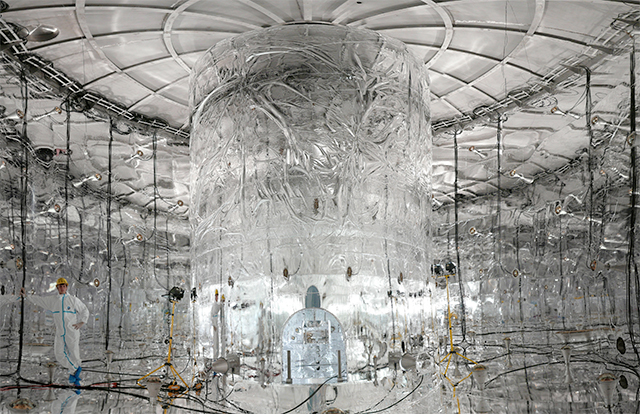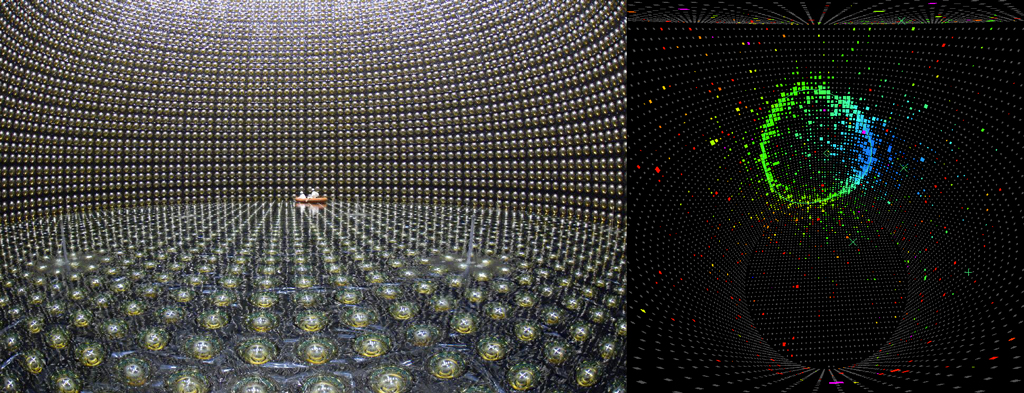Search Escalates for Key to Why Matter Exists

It felt like the Apollo control room seconds before the moon landing. For the approximately 60 physicists crowded into a conference room at the Joint Institute for Nuclear Research in Dubna, Russia, on June 14, this was the moment of truth. After nearly a decade of work, the result of their painstaking search for one of the rarest radioactive decay processes in the universe — if it exists — was about to be revealed.
The hunting grounds were 15 kilograms of pure Germanium crystals kept in extreme isolation deep under a mountain in Italy. Members of the GERmanium Detector Array (GERDA) Collaboration had monitored electrical activity inside the crystals hoping to detect “neutrino-less double beta decay,” a spontaneous reshuffling of particles inside the nucleus of a Germanium-76 atom that would recast it as Selenium-76. The chemical decay could present a solution to one of the biggest mysteries in physics: why there is something rather than nothing in the universe.
Among the bedlam of electrical activity caused by other types of decays, detector noise and rogue radiation, the physicists expected their instruments to pick up two or three spikes of background noise closely resembling the spikes from neutrino-less double beta decay. But they needed a stronger signal — eight or 10 spikes — to be convinced that they had really detected it.
On a large screen at the front of the room, the answer appeared: three spikes. “As soon as we saw the number, it was clear there was no signal,” said Allen Caldwell, director of the Max Planck Institute for Physics in Munich and a member of the GERDA Collaboration. But the negative finding was still a victory. Previous searches for neutrino-less double beta decay had been fouled by uncontrolled background noise. GERDA’s extreme sensitivity and spot-on background estimate allowed the researchers to definitively rule out a signal. “Everybody had their cameras out and was taking pictures of the screen and slapping each other on the back,” Caldwell said.
The null result, reported Sept. 19 in Physical Review Letters, indicates that it takes at least 30 trillion trillion years — two thousand trillion times the age of the universe — for half of the Germanium-76 atoms in a sample to undergo the decay, if they do it at all. If the “half-life” were much shorter, GERDA would have detected a signal. Because a longer half-life means a rarer decay, the scientists now know they need to monitor a larger sample of Germanium.
“It’s always difficult to convey why a negative result is an exciting result,” said Stefan Schönert, a physicist at Technical University of Munich and spokesman for the GERDA Collaboration. But it’s simple, he said: “Our experiment worked.”
Out of the Void
According to the Standard Model of particle physics, the universe should be empty. Matter and antimatter, which are identical except for their opposite electric charges, seem to be produced in equal parts during particle interactions and decays. However, matter and antimatter instantly annihilate each other upon contact, and so equal amounts of each would have meant a wholesale annihilation of both shortly after the Big Bang. The existence of galaxies, planets and people illustrates that somehow, a small surplus of matter survived this canceling process. If that hadn’t happened, “the universe would be void,” Schönert said. “It would be very, very boring for us, who would not exist.”
The explanation for the survival of some matter may lie in subatomic particles called neutrinos. These particles might have a special property that would give rise to neutrino-less double beta decay.
When an atom undergoes one type of beta decay, a neutron inside its nucleus spontaneously transforms into a proton, electron and antineutrino (the antimatter counterpart of the neutrino); in a type of inverse beta decay, the neutron absorbs a neutrino and morphs into a proton and electron.
In neutrino-less double beta decay, both processes would happen in tandem: The antineutrino produced by the first type of decay would serve as the neutrino that enters into the second. Such a dual reaction can occur only if neutrinos and antineutrinos are one and the same particle, as the Italian physicist Ettore Majorana hypothesized in 1937. Because neutrinos are electrically neutral, nothing forbids them from being “Majorana particles,” or both matter and antimatter at once.
“It seems natural that the neutrino is its own antiparticle,” said Bernhard Schwingenheuer, a physicist at the Max Planck Institute for Nuclear Physics in Heidelberg, Germany. “And in this case, neutrino-less double beta decay should exist.”
If the decay does exist, proving neutrinos are Majorana particles, this could explain the matter-antimatter asymmetry.
A widely supported hypothesis called the seesaw mechanism predicts that Majorana neutrinos would come in two varieties: the lightweight ones observed today and heavy ones that could have subsisted only in a high-energy environment like the newborn universe. (Their masses have an inverse relationship, like two sides of a seesaw.) The theory was originally developed to explain why neutrinos are far less massive than the other particles of the Standard Model, but it also suggests a means for the surplus of matter.
A fraction of a second after the Big Bang, those primordial heavy neutrinos would have undergone a process known as leptogenesis: Calculations show they would have decayed asymmetrically, generating slightly fewer leptons (electrons, muons and tau particles) than antileptons. By a conventional Standard Model process, the antilepton excess would then have cascaded into a one-part-per-billion excess of baryons (protons and neutrons) over antibaryons. “The baryons and antibaryons annihilated each other, and then the tiny imbalance left over is the matter we have today,” Caldwell said.
“If the neutrino is its own antiparticle, then the so-called leptogensis mechanism to explain the matter-antimatter asymmetry will be very plausible,” Schwingenheuer said.
Although alternative theories exist, it’s the most popular, straightforward, economical way to explain the asymmetry, the physicists said. And it would get a huge boost from eight or 10 electrical spikes of experimental evidence.
New Life for Decay
Physicists recognized more than half a century ago that observing neutrino-less double beta decay would prove that neutrinos are Majorana particles. But until the late 1990s, they “simply had very little idea of where to look,” said Alan Poon, a neutrino physicist at Lawrence Berkeley National Laboratory. They knew the decay could occur in an isotope like Germanium-76, which packs more energy in its nucleus than the isotope it would become, two spots over on the periodic table. But they had no idea how rare the decay might be, and consequently, how much Germanium they had to monitor or for how long. Without a range of possibilities for the half-life of the decay, their task felt like searching for “treasure at the bottom of the Atlantic,” Poon said, an ordeal made worse by the possibility that there might be nothing to find.
The half-life in Germanium-76 and other isotopes can be calculated from the mass of the lightweight neutrinos. Experiments over the past two decades have shown that these neutrinos oscillate between three “flavors” — electron, muon and tau — each with its own combination of three unique masses. Although the masses themselves are unknown, the rate of the oscillations determines the possible differences between them. These in turn dictate three possible ranges for the half-life of neutrino-less double beta decay, stretching between a few trillion trillion and a few thousand trillion trillion years. It’s a vast and remote range, but finite.

“Neutrino oscillations put a light at the end of the tunnel,” Schönert said.
The results from GERDA — one of the most sensitive searches for neutrino-less double beta decay to date —indicated that the half-life range must start at a higher point. The outcome corroborates recent results by the EXO-200 and KamLAND-Zen experiments that together put a lower limit on the half-life of the decay in Xenon-136, another isotope that may exhibit the decay, at 34 trillion trillion years. The physicists in these various collaborations can now continue methodically working their way through the range of possible half-lives.
The longer the half-life is, the rarer the decay and thus the more atoms must be monitored to see it. The upgraded GERDA Phase II experiment will begin collecting data from 40 kilograms of Germanium early next year; the decay should be seen by the end of the three-year run if its half-life is less than 100 trillion trillion years. Several more searches, including the U.S.-based Majorana Demonstrator experiment, are under construction, and a next generation of even more sensitive searches is planned. Bigger samples mean more background noise, and so each new experiment must be even more stringently controlled than the last.
Most neutrino physicists expect to eventually find the decay. “There’s this prejudice because of the beauty of the theory of Majorana neutrinos,” said Schönert, “but no guarantee that this is the true story.”
This article has been reprinted on ScientificAmerican.com.



